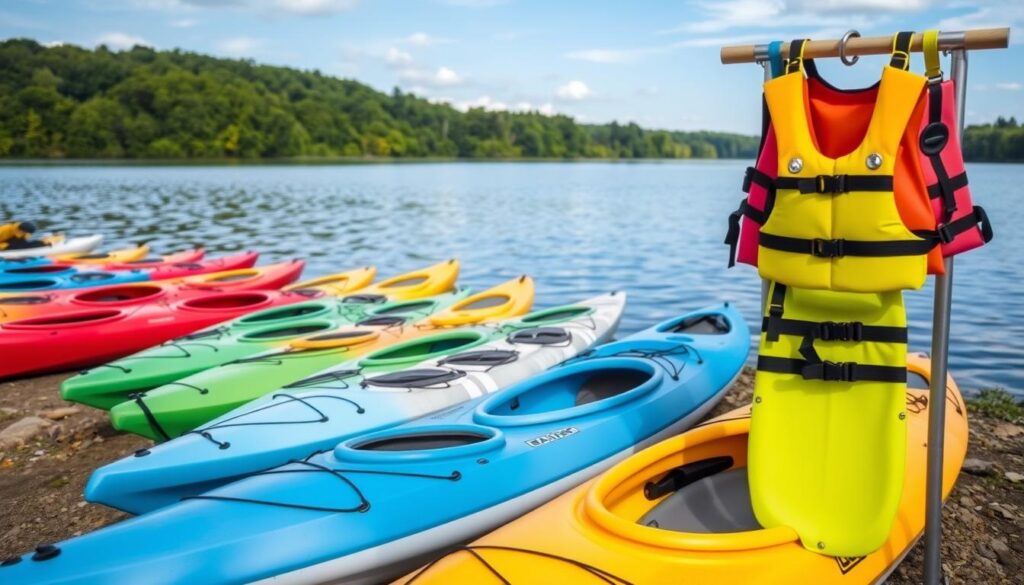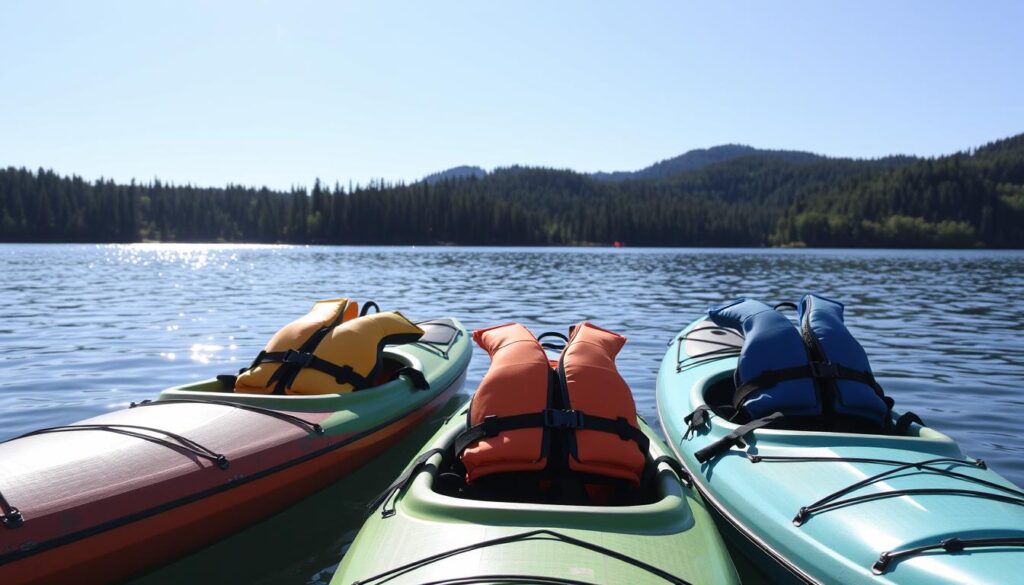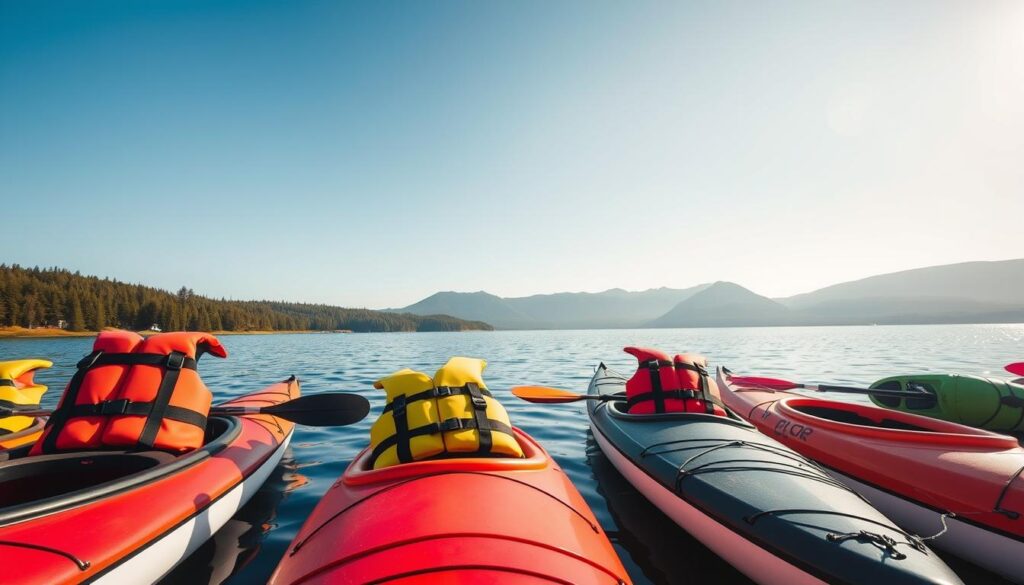- Key Takeaways
- Understanding Life Jacket Requirements for Kayaking
- Are Life Jackets Required in a Kayak: Legal Guidelines Explained
- Types of Personal Flotation Devices Approved for Kayaking
- Essential Safety Features of Kayaking Life Vests
- Proper Fit and Sizing Guidelines for Kayak Life Jackets
- When You Can Skip Wearing a Life Jacket While Kayaking
- Penalties and Fines for Non-Compliance with PFD Laws
- Maintaining and Inspecting Your Kayaking Life Jacket
- Special Considerations for Different Kayaking Environments
- Common Myths About Kayak Life Jacket Requirements
- Conclusion
- FAQ
- Are life jackets always required when kayaking?
- Do children have different life jacket requirements?
- What type of life jacket is best for kayaking?
- How do I know if my life jacket fits correctly?
- Are there penalties for not wearing a life jacket while kayaking?
- Do I need a life jacket in calm lake waters?
- How often should I replace my kayaking life jacket?
- Are inflatable life jackets legal for kayaking?
- Do professional kayakers always wear life jackets?
- Can I be exempt from wearing a life jacket while kayaking?

Kayaking is an exciting water sport that requires careful safety attention. Knowing if life jackets are needed in a kayak can be life-saving. Whether you’re experienced or new, it’s key to follow safety guidelines for your own protection.
Personal flotation devices are not just a good idea; they’re often the law in many places. Your safety relies on understanding and following the right kayaking safety rules. This includes wearing life jackets in different situations and locations.
This guide will cover everything you need to know about life jacket rules. It aims to help you make safe choices for your kayaking adventures.When it comes to enjoying the great outdoors, few activities compare to the thrill of kayaking. The serene beauty of gliding across water, surrounded by nature, is a quintessential experience for many paddlers. However, as exhilarating as it is, safety must always come first. One of the most crucial elements of safety in paddle sports is the life jacket. Whether you’re cruising along a calm lake or navigating a rushing river, understanding the regulations and best practices associated with life jackets can significantly impact your safety and enjoyment.
In this guide, we’ll explore the fundamental question: Are life jackets required in a kayak? We’ll delve into essential regulations, local laws, and practical tips that every paddler should know. By the end, you’ll be equipped with the knowledge you need to make informed decisions and ensure a safe and enjoyable kayaking adventure—because when it comes to paddle sports essentials, wearing a life jacket is non-negotiable.
Key Takeaways
- Life jackets are critical for kayak safety in most waterways
- Regulations vary by state and water conditions
- Different types of personal flotation devices serve specific purposes
- Proper fit is essential for life jacket effectiveness
- Legal requirements can change based on age and location
Understanding Life Jacket Requirements for Kayaking
Kayak lovers face a tough challenge in boating rules. Safety begins with knowing the rules for personal flotation devices (PFDs). These rules change based on where you are and the situation.

A
Kayaking safety isn’t the same for everyone. Your gear must meet legal standards to keep you safe while enjoying water sports.
Federal vs State Regulations
The U.S. Coast Guard sets basic safety rules for water sports. But, states can add their own rules. The main differences are:
- States might have stricter rules
- Local waters can have their own rules
Age-Specific Requirements
Life jacket laws often depend on your age. Most states have clear guidelines:
| Age Group | Typical Requirements |
|---|---|
| Children under 13 | Must wear Coast Guard-approved life jacket |
| Teenagers 13-18 | Recommended but not always mandated |
| Adults 18+ | Personal choice with strong safety recommendation |
Seasonal Considerations
Water conditions change with the seasons. Cold water environments demand extra precautions.
“Your safety is only as good as your preparation.” – National Water Safety Council
Following these rules is more than avoiding fines. It’s about keeping yourself safe and enjoying kayaking responsibly.
Are Life Jackets Required in a Kayak: Legal Guidelines Explained
Understanding kayaking laws can be complex. But knowing life vest requirements is key for your safety and legal compliance. Federal and state regulations set clear guidelines for wearing life jackets while kayaking.

The U.S. Coast Guard sets strict legal standards for life jacket use in kayaks. These kayaking laws require each vessel, including kayaks, to have a U.S. Coast Guard-approved personal flotation device for each person onboard.
“Safety isn’t expensive, it’s priceless” – Unknown Paddler
- Children under 13 must always wear life jackets
- Adults must have a life vest readily accessible
- Life jacket must be appropriate for water conditions
Different states have their own life vest requirements. Some key considerations include:
| State | Age Requirement | Life Vest Mandate |
|---|---|---|
| California | Under 13 | Required |
| Florida | Under 16 | Required |
| New York | Under 12 | Required |
Your safety depends on understanding and following these are life jackets required in a kayak regulations. Always check local kayaking laws before heading out on the water.
Types of Personal Flotation Devices Approved for Kayaking
Choosing the right personal flotation device (PFD) is key for kayaking safety. Not all life jackets are the same. Knowing the different types helps you pick the best for your needs.
The U.S. Coast Guard groups PFDs into three main types. Each is made for certain boating safety needs and water conditions.
Type I: Offshore Life Jackets
Type I PFDs are the strongest. They have:
- Highest buoyancy rating
- Best for rough waters
- Good for open, remote water
- Can turn unconscious wearers face-up
Type II: Near-Shore Vests
Type II PFDs are great for calm waters and near-shore kayaking. They have:
- Moderate buoyancy
- Lighter and more comfy
- Good for lakes and calm rivers
- Less bulky than Type I
Type III: Flotation Aids
Type III PFDs are popular among kayakers. They offer great mobility and comfort. They are:
- Designed for active water sports
- Allow maximum arm movement
- Lightweight
- Perfect for recreational kayaking
“Always choose a Coast Guard-approved PFD that fits properly and matches your kayaking environment.” – National Water Safety Experts
| PFD Type | Best Used For | Buoyancy Level |
|---|---|---|
| Type I | Offshore/Rough Waters | Highest (22+ lbs) |
| Type II | Near-Shore/Calm Waters | Moderate (15.5 lbs) |
| Type III | Recreational Kayaking | Good (15.5 lbs) |
Pro tip: Think about your kayaking spot and what feels right for you when picking a PFD.
Essential Safety Features of Kayaking Life Vests
When picking out kayak safety gear, it’s key to know the vital safety features of personal flotation devices. A top-notch life vest does more than just keep you afloat. It has many features that can save your life in unexpected water situations.
- High-visibility color panels
- Integrated emergency whistle
- Reflective strips for low-light conditions
- Quick-release buckles
- Multiple adjustment points
Being seen can save your life in water emergencies. Bright colors like orange, yellow, and red help rescuers spot you fast in tough conditions. Reflective materials make you more visible at dawn, dusk, or night.
“A life vest is not just a piece of equipment, it’s your primary safety companion on the water.” – Coast Guard Water Safety Expert
Today’s personal flotation devices for kayaking use advanced materials. They are both strong and comfy. Breathable fabrics and designs that fit your body let you paddle freely while staying safe.
| Safety Feature | Purpose | Importance |
|---|---|---|
| High-Visibility Color | Emergency Detection | Critical |
| Emergency Whistle | Signaling for Help | Essential |
| Reflective Strips | Low-Light Visibility | Important |
Investing in good kayak safety gear can really change your water sports experience. Always choose features that boost your safety and comfort while kayaking.
Proper Fit and Sizing Guidelines for Kayak Life Jackets
Choosing the right personal flotation device is key for kayaking safety. Your life jacket must fit perfectly for maximum protection on the water. A life jacket that doesn’t fit right can put your safety at risk.
Proper sizing is important for every kayaker to know. A well-fitted life jacket can save your life in emergencies.
Measuring for the Right Size
To find your ideal life jacket size, follow these steps:
- Measure your chest circumference at the widest point
- Check manufacturer’s specific sizing charts
- Try on multiple sizes to ensure a snug fit
- Ensure you can move freely without restriction
Critical Adjustment Points
Key adjustment areas include:
- Shoulder straps
- Waist/side straps
- Chest buckle
- Back closure mechanism
Weight Capacity Considerations
Weight matters significantly when choosing personal flotation devices. Different kayaking accessories are designed for specific weight ranges. Always choose a life jacket that supports your body weight for proper buoyancy and safety.
“A life jacket that doesn’t fit is no life jacket at all.” – Experienced Kayaking Instructor
Your life jacket should feel comfortable yet secure. When properly fitted, it should not ride up when you raise your arms or move around.
When You Can Skip Wearing a Life Jacket While Kayaking
Kayaking safety is key, but there are times when you might not need a life jacket. Knowing when these times are helps you follow boating rules well.
- Professional competitive kayaking events with immediate safety personnel
- Designated swimming areas with controlled water conditions
- Supervised training sessions with professional instructors
“Safety should always be your primary consideration, regardless of legal exceptions.” – US Coast Guard Boating Safety Division
Professional kayaking groups say these exceptions are rare. Even when you don’t have to wear a life jacket, experts suggest you do.
What decides if you can skip the life jacket includes:
- Water temperature
- Proximity to shore
- Weather conditions
- Skill level of the kayaker
Remember: No legal exception is worth risking your life. Always prioritize personal safety over temporary convenience.
Penalties and Fines for Non-Compliance with PFD Laws
Kayaking safety is not just about personal protection—it’s a legal requirement. Not following boating regulations and kayaking laws can lead to serious consequences. These go beyond just personal risk.
Knowing the legal risks of ignoring life vest rules can push kayakers to focus on safety. The penalties differ a lot between federal and state laws. It’s very important to know the specific rules in your area.
Federal Penalties for Non-Compliance
The U.S. Coast Guard is very serious about life jacket rules. Breaking these rules can result in:
- Fines up to $500 for first-time offenders
- Potential vessel seizure
- Mandatory court appearances
- Points added to boating records
State-Specific Consequences
State penalties for ignoring kayaking laws can be even stricter. Many states have:
- Escalating fine structures
- Potential boating license suspension
- Mandatory safety course requirements
“Safety isn’t expensive, it’s priceless—especially on the water.” – U.S. Coast Guard Safety Division
Kayakers should always check local regulations to understand the specific life vest requirements and potential penalties in their region.
Maintaining and Inspecting Your Kayaking Life Jacket
Keeping your kayak safety gear in good shape is key. Your life jacket is a vital part of your paddle sports kit. It needs regular care to stay effective.
Checking your personal flotation devices often is important. It helps avoid safety issues while you’re on the water. Here are some steps to keep your gear in top shape:
- Rinse with fresh water after each use
- Check for tears, fraying, or material degradation
- Inspect buckles and straps for functionality
- Store in a cool, dry place away from direct sunlight
- Avoid storing near sharp objects or chemicals
Signs that your personal flotation devices need to be replaced include:
| Condition | Action Required |
|---|---|
| Significant fabric wear | Replace immediately |
| Broken or rusted buckles | Replace hardware or entire device |
| Mildew or persistent odor | Professional cleaning or replacement |
“A well-maintained life jacket can be the difference between life and death on the water.” – US Coast Guard Safety Guidelines
Professional kayakers suggest checking your gear twice a year. By taking the time to maintain your kayak safety gear, you’ll stay safe on the water.
Special Considerations for Different Kayaking Environments
Kayaking in different waters has its own set of challenges. You need the right water sports equipment and kayaking accessories for each place. Knowing the boating safety guidelines is key to staying safe in various water landscapes.
Water conditions greatly affect your kayaking safety. Each place has its own needs for safety gear and preparation:
- Calm Lakes: Minimal wave action requires lighter kayaking accessories
- Coastal Waters: Unpredictable conditions demand robust safety gear
- River Environments: Fast currents need specialized flotation devices
Think about these important factors when choosing your safety gear:
| Environment | Key Safety Considerations | Recommended Gear |
|---|---|---|
| Ocean/Coastal | High wave potential, wind exposure | Type I offshore life jacket |
| Rivers | Strong currents, potential obstacles | Type III flotation aid |
| Lakes | Generally calm conditions | Type II near-shore vest |
“Your safety gear is your lifeline in unpredictable water conditions.” – Professional Kayaking Association
Temperature is also crucial for your safety. In cold water, you need extra layers and special safety tips. Always check the local conditions and get ready to have a safe and fun kayaking trip.
Common Myths About Kayak Life Jacket Requirements
Kayaking safety is about knowing the truth. Many believe wrong things about life jackets, which can be dangerous.
It’s easy to get lost in kayaking laws and boating rules. Let’s clear up some common myths about life jackets.
Debunking Safety Misconceptions
- Myth: Life jackets are only necessary for inexperienced kayakers Even experienced swimmers and skilled paddlers need life jackets. No one is safe from unexpected water dangers.
- Myth: Modern kayaks make life jackets unnecessary Kayaking laws say you must wear personal flotation devices, no matter the kayak design. Accidents can happen to anyone.
- Myth: Life jackets are uncomfortable and restrict movement Today’s life jackets are made for comfort and flexibility. They are a key part of kayak safety.
Understanding Real-World Applications
Kayakers need to know safety isn’t just about skill. It’s about the unpredictable water. Boating rules require life jackets for a reason.
“Safety is not an accident. It’s a choice.” – Unknown Kayaking Expert
| Myth | Reality |
|---|---|
| Life jackets are optional | Legally required in most water environments |
| Good swimmers don’t need life jackets | Everyone is vulnerable to water emergencies |
| Life jackets are bulky | Modern designs are lightweight and flexible |
Knowing these myths helps you make better choices about kayak safety. Always put your safety first on the water.
Conclusion
Kayaking is full of amazing adventures, but safety comes first. Knowing and using the right personal flotation devices is key. It can turn a good trip into a great one.
Every kayaker must follow boating safety rules. These aren’t just suggestions; they’re essential for staying safe.
Going on the water is more than just paddling. It’s about being ready for anything. Life jackets are your first line of defense against water dangers.
They keep you safe on calm lakes or rough rivers. Wearing a life jacket is a must, no matter the conditions.
Your kayaking trips should always focus on safety. Learn about the latest rules, buy good gear, and always wear your life jacket. Following these steps makes kayaking safer and more enjoyable.
Knowledge, being prepared, and safety habits are your allies on the water. Keep yourself safe, care for the environment, and encourage others to do the same.
FAQ
Are life jackets always required when kayaking?
Yes, most places require a Coast Guard-approved life jacket when kayaking. This rule applies to everyone on the water, no matter how good a swimmer you are.
Do children have different life jacket requirements?
Yes, kids face stricter rules. In most states, kids under 12 must wear a life jacket at all times on the water.
What type of life jacket is best for kayaking?
A Type III personal flotation device is best for kayaking. They are designed for paddle sports, offering safety and comfort.
How do I know if my life jacket fits correctly?
Your life jacket should fit snugly but not too tight. You should be able to lift your arms overhead without it moving up. Always check the size guide and adjust the straps for a good fit.
Are there penalties for not wearing a life jacket while kayaking?
Yes, not wearing a life jacket can lead to fines and legal trouble. The amount can vary, but it’s always worth the safety.
Do I need a life jacket in calm lake waters?
Even in calm waters, wearing a life jacket is recommended and often required. It’s crucial for your safety, no matter the water conditions or your swimming skills.
How often should I replace my kayaking life jacket?
Check your life jacket every year and replace it every 5-10 years. Replace it immediately if it’s damaged or worn out. Always follow the manufacturer’s advice on maintenance and replacement.
Are inflatable life jackets legal for kayaking?
Inflatable life jackets are legal for kayaking if they’re Coast Guard-approved. They’re light and comfy but need more care and might not be right for all kayaking spots.
Do professional kayakers always wear life jackets?
Yes, professional kayakers always wear life jackets. They show the importance of safety gear, even for experienced paddlers.
Can I be exempt from wearing a life jacket while kayaking?
Rarely, and only in very specific situations. Generally, there are no broad exemptions from wearing a life jacket. Safety rules are in place to protect all kayakers, no matter their skill or swimming ability.

